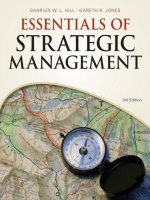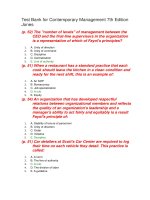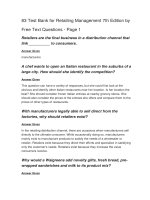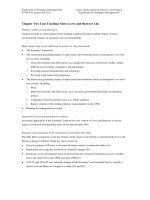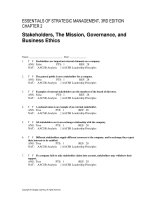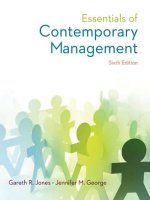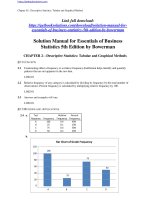Essentials of contemporary management 7th edition by jones george test bank
Bạn đang xem bản rút gọn của tài liệu. Xem và tải ngay bản đầy đủ của tài liệu tại đây (784.54 KB, 123 trang )
Essentials of Contemporary Management 7th edition by Gareth R Jones, Jennifer M.
George Test Bank
Link full download test bank: />Link full download solution manual: />Chapter 02. Values, Attitudes, Emotions, and Culture: The Manager as a Person
True / False Questions
1. The tendency of a manager to feel distressed and be critical of himself or herself and others
is called negative affectivity.
True False
2. Managers who are high on the conscientiousness continuum are organized and self-
disciplined. True False
3. Since managers are accountable for ensuring that organizations and their members behave in an
ethical fashion, they need an external locus of control.
True False
4. The need for affiliation is the extent to which a manager has a strong interest in
performing challenging tasks well and to meet personal standards of excellence.
True False
5. A personal conviction about lifelong goals or objectives is called a terminal value.
True False
2-1
Copyright © 2017 McGraw-Hill Education. All rights reserved. No reproduction or distribution without the prior written consent of
McGraw-Hill Education.
6. Levels of job satisfaction tend to increase as one moves up the hierarchy in an organization.
True False
7. Downsizing tends to increase employee satisfaction because employees' increased workloads
make them feel more responsible and empowered.
True False
8. Differences in the levels of organizational commitment among managers in different countries
are likely because these managers have different kinds of opportunities and rewards.
True False
9. People who are low on extraversion still experience positive moods.
True False
10. Emotional intelligence concerns understanding and managing the moods and emotions of others
but not oneself.
True False
11. When organizational members share an intense commitment to cultural values, beliefs,
and routines and use them to achieve their goals, a strong organizational culture exists.
True False
12. The personal characteristics of the founders of an organization have an important role in
the creation of the organization's culture.
True False
2-2
Copyright © 2017 McGraw-Hill Education. All rights reserved. No reproduction or distribution without the prior written consent of
McGraw-Hill Education.
13. The attraction-selection-attrition framework suggests that employees who are dissimilar in
personality from that of the founders are more likely to leave the organization over time.
True False
14. The terminal values and not the instrumental values of managers play a role in determining
organizational culture.
True False
15. Organizational socialization is the process by which newcomers learn an organization's values
and norms and acquire the work behaviors necessary to perform jobs effectively.
True False
Multiple Choice Questions
16. An individual's enduring tendencies to feel, think, and act in certain ways are referred to as
his/her ________.
A. personality traits
B. terminal values
C. norms
D. attitudes
E. moods
2-3
Copyright © 2017 McGraw-Hill Education. All rights reserved. No reproduction or distribution without the prior written consent of
McGraw-Hill Education.
17. What are the Big Five personality traits?
A. Extraversion, tension, perfectionism, self-reliance, and apprehension
B. Extraversion, negative affectivity, agreeableness, conscientiousness, and openness to
experience
C. Extraversion, negative affectivity, agreeableness, conscientiousness, and tension
D. Extraversion, negative affectivity, agreeableness, tension, and perfectionism
E. Extraversion, negative affectivity, tension, perfectionism, and self-reliance
18. The tendency to experience positive emotions and moods and feel good about oneself and
the rest of the world is known as ________.
A. conscientiousness
B. openness to experience
C. rationality
D. extraversion
E. social recognition
19. People who tend to be sociable, outgoing, and friendly are said to ________.
A. be extraverts
B. be introverts
C. have low self-esteem
D. be conscientious
E. have an internal locus of control
2-4
Copyright © 2017 McGraw-Hill Education. All rights reserved. No reproduction or distribution without the prior written consent of
McGraw-Hill Education.
20. Max enjoys being the center of attraction during his office parties. He has excellent social skills
and easily makes friends with new employees. He can rightly be said to ________.
A. have an internal locus of control
B. be an extravert
C. have a low self-esteem
D. be an introvert
E. be conscientious
21. People who are less inclined toward social interactions and to have a less positive outlook are
known to be ________.
A. optimistic
B. dominant
C. introverts
D. agreeable
E. extraverts
22. Steven is an effective and efficient manager. However, he is quite pessimistic and avoids
social interactions. Steven can be classified as an ________.
A. extravert
B. individual with a high external locus of control
C. individual with high self-esteem
D. introvert
E. individual who is open to change
2-5
Copyright © 2017 McGraw-Hill Education. All rights reserved. No reproduction or distribution without the prior written consent of
McGraw-Hill Education.
23. The tendency of a person to feel bad emotions and moods, to feel distressed, and to be critical
of oneself and others is called ________.
A. agreeableness
B. conscientiousness
C. negative affectivity
D. high on self-esteem
E. optimism
24. Edward, a manager at Real Corp., is a very positive individual. He rarely exhibits adverse
emotions or moods and is always optimistic about himself and others. It can be said that Edward
is ________.
A. low on negative affectivity
B. low on agreeableness
C. high on conscientiousness
D. high on self-esteem
E. an extravert
25. The tendency to get along well with others is known as ________.
A. need for affiliation
B. agreeableness
C. conscientiousness
D. self-esteem
E. need for achievement
2-6
Copyright © 2017 McGraw-Hill Education. All rights reserved. No reproduction or distribution without the prior written consent of
McGraw-Hill Education.
26. Penelope is a manager with Quick Pizza. She is very good at understanding the feelings of her
subordinates and takes time out for all of them. She listens to their problems, sympathizes with
them, and tries her best to give them solutions regarding the same. From this information, it
can be said that Penelope is ________.
A. an introvert
B. a pessimist
C. high on agreeableness
D. low on conscientiousness
E. high on ambition
27. ________ is the tendency to be careful, scrupulous, and persevering.
A. Conscientiousness
B. Openness to experience
C. Need for achievement
D. Agreeableness
E. Extraversion
28. Managers who are ________ appear to lack direction and self-discipline.
A. low on negative affectivity
B. low on conscientiousness
C. low on agreeableness
D. extraverts
E. optimists
2-7
Copyright © 2017 McGraw-Hill Education. All rights reserved. No reproduction or distribution without the prior written consent of
McGraw-Hill Education.
29. Managers who have high conscientiousness are known to be ________.
A. introverts
B. open to experience
C. low on agreeableness
D. organized and self-disciplined
E. extroverts
30. ________ is the tendency to be original, have broad interests, be daring, and take risks.
A. Agreeableness
B. Conscientiousness
C. Openness to experience
D. Introversion
E. Negative affectivity
31. As a manager, Nancy is known in the company as a risk-taker and an innovator. Nancy is
________.
A. high on introversion
B. low on agreeableness
C. high on openness to experience
D. high on negative affectivity
E. high on conscientiousness
2-8
Copyright © 2017 McGraw-Hill Education. All rights reserved. No reproduction or distribution without the prior written consent of
McGraw-Hill Education.
32. Brian has been employed at Precision Services for nearly 10 years. He is an effective manager
but does not like to take risks. Brian is more comfortable following guidelines and maintaining
the status quo. Brian is ________.
A. low on conscientiousness
B. high on extraversion
C. high on agreeableness
D. low on openness to experience
E. high on the need for affiliation
33. People who have ________ believe they themselves are responsible for their own fate; they
see their own actions and behaviors as being major and decisive determinants of important
outcomes.
A. low self-esteem
B. a low sense of achievement
C. high neuroticism
D. an internal locus of control
E. an external locus of control
34. Whenever Cate does not perform well in a test, she blames it on the lack of preparedness on
her part. Cate is said to have ________.
A. an external locus of control
B. low self-esteem
C. a low sense of achievement
D. high neuroticism
E. an internal locus of control
2-9
Copyright © 2017 McGraw-Hill Education. All rights reserved. No reproduction or distribution without the prior written consent of
McGraw-Hill Education.
35. Identify the personality trait that makes people accountable and responsible for their own
actions and ensures ethical behavior in an organization.
A. Self-esteem
B. Conscientiousness
C. Internal locus of control
D. External locus of control
E. Attitude
36. People who believe that outside forces are responsible for what happens to and around them and
do not think that their own actions make much of a difference have ________.
A. a high sense of achievement
B. less neuroticism
C. an internal locus of control
D. an external locus of control
E. high self-esteem
37. Whenever Daniel performs well in a test, he thinks that his teacher was being lenient or that he
was lucky. Daniel is said to have ________.
A. an internal locus of control
B. high self-esteem
C. a high sense of achievement
D. low neuroticism
E. an external locus of control
2-10
Copyright © 2017 McGraw-Hill Education. All rights reserved. No reproduction or distribution without the prior written consent of
McGraw-Hill Education.
38. ________ is the degree to which individuals feel good about themselves and their capabilities.
A. Self-esteem
B. Attitude
C. Emotional intelligence
D. Self-criticism
E. Hedonism
39. As the night manager of Spicy Bites, Ronald feels competent, deserving, and capable of handling
most situations. Ronald ________.
A. has an external locus of control
B. has low sense of achievement
C. has high self-esteem
D. is highly hedonistic
E. is highly self-critical
40. Steve, a middle manager working at KT Corp., is unable to judge his own capabilities and has a
poor opinion of himself; Steve is likely to have ________.
A. less external locus of control
B. low self-esteem
C. less need for affiliation
D. less openness to experience
E. low level of agreeableness
2-11
Copyright © 2017 McGraw-Hill Education. All rights reserved. No reproduction or distribution without the prior written consent of
McGraw-Hill Education.
41. Which of the following traits is likely to help a manager in keeping high standards for himself
or herself and pushing ahead on hard projects?
A. High neuroticism
B. High need for affiliation
C. High external locus of control
D. High need for power
E. High self-esteem
42. According to psychologist David McClelland, the extent to which an individual has a strong
desire to perform challenging tasks well and to meet personal standards for excellence is known
as the individual's need for ________.
A. affiliation
B. achievement
C. power
D. affection
E. conscientiousness
43. Jane, a first-line manager in an advisory firm, shows consistent interest in taking up challenging
tasks. She keeps clear goals for herself and likes to get regular feedback for her performance
in all levels. Which of the following personality traits best reflects her behavior?
A. Need for affiliation
B. External locus of control
C. Need for power
D. Need for achievement
E. Social behavior
2-12
Copyright © 2017 McGraw-Hill Education. All rights reserved. No reproduction or distribution without the prior written consent of
McGraw-Hill Education.
44. The need for ________ is the extent to which an individual is concerned about establishing
and maintaining good interpersonal relations, being liked, and having the people around him
or her get along with one another.
A. power
B. self-esteem
C. conscientiousness
D. achievement
E. affiliation
45. The extent to which an individual desires to control or influence others is known as the
individual's need for ________.
A. affiliation
B. affection
C. power
D. conscientiousness
E. benevolence
46. Which of the following describes what managers are trying to achieve through work and how they
think they should behave?
A. Emotions
B. Moods
C. Intelligence
D. Values
E. Attitudes
2-13
Copyright © 2017 McGraw-Hill Education. All rights reserved. No reproduction or distribution without the prior written consent of
McGraw-Hill Education.
47. A(n) ________ value is a personal conviction about lifelong goals or objectives.
A. terminal
B. instrumental
C. moral
D. means
E. competence-related
48. A(n) ________ value is a personal conviction about desired modes of conduct or ways
of behaving.
A. terminal
B. personal
C. social
D. ends
E. instrumental
49. Unwritten, informal codes of conduct that prescribe how people should act in particular situations
and are considered important by most members of a group are known as ________.
A. norms
B. goals
C. values
D. ideologies
E. rules
2-14
Copyright © 2017 McGraw-Hill Education. All rights reserved. No reproduction or distribution without the prior written consent of
McGraw-Hill Education.
50. Which of the following refers to the terminal and instrumental values that are guiding principles
in an individual's life?
A. Value system
B. Organization values
C. Grading system
D. Ruling system
E. Regulations and norms
51. Which of the following is an example of a terminal value?
A. Self-reliant
B. Self-sufficient
C. Self-respect
D. Self-controlled
E. Self-disciplined
52. Jayden, a production manager at AKC Inc., has successfully developed a cost-effective
nebulizer that has made a lasting contribution to the firm. Which of the following terminal values
of Jayden is discussed here?
A. Need for affiliation
B. Sense of accomplishment
C. Need for power
D. Self-esteem
E. Need for recognition
2-15
Copyright © 2017 McGraw-Hill Education. All rights reserved. No reproduction or distribution without the prior written consent of
McGraw-Hill Education.
53. A(n) ________ is a collection of feelings and beliefs.
A. habit
B. attitude
C. value
D. norm
E. aptitude
54. The collection of feelings and beliefs that managers have about their current jobs is referred to as
________.
A. organizational citizenship behavior
B. job satisfaction
C. organizational culture
D. organizational commitment
E. emotional intelligence
55. Organizational citizenship behaviors are an employee's ________.
A. strict adherence to organizational goals
B. willingness to perform above and beyond the call of duty
C. indisposition to offer suggestions to the organization
D. emotional attachment to the organization
E. collection of feelings and beliefs about the organization as a whole
2-16
Copyright © 2017 McGraw-Hill Education. All rights reserved. No reproduction or distribution without the prior written consent of
McGraw-Hill Education.
56. The collection of feelings and beliefs that managers have about their organization as a whole
is known as organizational ________.
A. commitment
B. climate
C. citizenship
D. socialization
E. culture
57. Sharon is working as a shift manager at XT, Inc. She has a high degree of loyalty toward her
organization and is proud of what the organization stands for. Sharon is likely to have
organizational ________.
A. culture
B. efficiency
C. commitment
D. value
E. development
58. Managers who have ________________ perform some of their figurehead and spokesperson
roles and persuade others both inside and outside the organization of the organization's merits.
A. competitive advantage
B. organizational commitment
C. high self-esteem
D. need for power
E. organizational culture
2-17
Copyright © 2017 McGraw-Hill Education. All rights reserved. No reproduction or distribution without the prior written consent of
McGraw-Hill Education.
59. Roger, manager of Spike & Co., is a person with relatively high levels of positive mood at work.
Predict the most likely condition of the subordinates under Roger.
A. Less creative ideas
B. Unhealthy work environment
C. Higher performance
D. Better salaries
E. More professional experience
60. Which of the following defines emotion?
A. A feeling or state of mind
B. Intense, relatively short-lived feelings
C. Superficial, relatively long-lived feelings
D. A condition
E. Clear, sound reasoning
61. People who are most likely to experience negative moods ________.
A. are high on negative affectivity
B. are low on negative affectivity
C. are low on positive affectivity
D. are high on positive affectivity
E. have balanced affectivity
2-18
Copyright © 2017 McGraw-Hill Education. All rights reserved. No reproduction or distribution without the prior written consent of
McGraw-Hill Education.
62. Which of the following refers to a feeling or state of mind?
A. Affect
B. Mood
C. Value
D. Emotional labor
E. Self-efficacy
63. An intense, relatively short-lived feeling is called a(n) ________.
A. emotion
B. value
C. motivation
D. commitment
E. attitude
64. Which term refers to the ability to understand and manage one's own moods and emotions and
those of other people?
A. Emotional intelligence
B. Critical thinking
C. Decision making
D. Cultural intelligence
E. Devil's advocacy
2-19
Copyright © 2017 McGraw-Hill Education. All rights reserved. No reproduction or distribution without the prior written consent of
McGraw-Hill Education.
65. One of the attributes that make Anthony an excellent manager is his ability to understand the
moods of his subordinates coupled with his ability to manage his own moods. Anthony has a high
level of ________.
A. fluid intelligence
B. intelligence quotient
C. emotional intelligence
D. crystallized intelligence
E. dispositional effect
66. Emotional intelligence can help managers perform interpersonal roles like that of a ________.
A. resource allocator
B. monitor
C. planner
D. liaison
E. decision maker
67. Emotional intelligence has the potential to contribute to effective ______ in multiple ways.
A. leadership
B. emotions
C. values
D. goals
E. feelings
2-20
Copyright © 2017 McGraw-Hill Education. All rights reserved. No reproduction or distribution without the prior written consent of
McGraw-Hill Education.
68. Organizational ________ comprises the shared set of beliefs, expectations, values, norms,
and work routines that influence how members of an organization relate to one another and
work together to achieve organizational goals.
A. planning
B. hierarchy
C. chart
D. structure
E. culture
69. Words Inc., Co. is a printing company that approaches customers directly to know their
requirements in detail, deliver the products before the scheduled time, and receive feedback from
the customers. Which of the following cultures does it exemplify?
A. Innovative
B. Entrepreneurial
C. Organizational
D. Conservative
E. Imaginative
70. Which of the following reflects the distinctive ways in which organizational members perform
their jobs and relate to others inside and outside the organization?
A. Organizational culture
B. Organizational capital
C. Organizational hierarchy
D. Organizational planning
E. Organizational structure
2-21
Copyright © 2017 McGraw-Hill Education. All rights reserved. No reproduction or distribution without the prior written consent of
McGraw-Hill Education.
71. Which of the following posits that when founders hire employees for their new ventures, they
tend to be drawn to and choose employees whose personalities are similar to their own?
A. Equity theory
B. Attraction-selection-attrition framework
C. Belief-desire-intentional framework
D. Organizational commitment
E. Socialization
72. ________ signify what an organization and its employees are trying to accomplish.
A. Emotions
B. Moods
C. Terminal values
D. Instrumental values
E. Attitudes
73. ________ guide how the organization and its members achieve organizational goals.
A. Attitudes
B. Emotions
C. Moods
D. Instrumental values
E. Terminal values
2-22
Copyright © 2017 McGraw-Hill Education. All rights reserved. No reproduction or distribution without the prior written consent of
McGraw-Hill Education.
74. According to the ASA model, identify the person who is responsible for having profound and longlasting effects on organizational culture.
A. Employees
B. Managers
C. Newcomers
D. Founders
E. Subordinates
75. The process by which newcomers learn an organization's values and norms and acquire the
work behaviors necessary to perform jobs effectively is known as organizational ________.
A. conscientiousness
B. socialization
C. planning
D. controlling
E. agreeableness
2-23
Copyright © 2017 McGraw-Hill Education. All rights reserved. No reproduction or distribution without the prior written consent of
McGraw-Hill Education.
76. In Dave's Steel Manufacturing Co., new employees go through a short orientation process after
their induction. During this process, they are told about the organization and its history, values,
jargon, culture, and procedures. They are then introduced to their work group, the specific
people they would work with, and are informed about their own role in the organization, the skills
needed to do their job, and both the formal procedures and informal norms. This is an example
of organizational ________.
A. controlling
B. planning
C. socialization
D. agreeableness
E. conscientiousness
77. The formal events that recognize incidents of importance to the organization as a whole and
to specific employees are known as ________.
A. values
B. rituals
C. stories
D. rites
E. norms
2-24
Copyright © 2017 McGraw-Hill Education. All rights reserved. No reproduction or distribution without the prior written consent of
McGraw-Hill Education.
78. The rites of ________ determine how individuals enter, advance within, and leave
the organization.
A. passage
B. integration
C. celebration
D. inauguration
E. enhancement
79. Every year on the Saturday prior to Christmas, Smart Enterprises holds its annual holiday party.
This is an example of a rite of ________.
A. enhancement
B. integration
C. inauguration
D. celebration
E. passage
80. Orbit Inc. puts out newspaper releases announcing employees' promotions. This is an example
of a rite of ________.
A. inauguration
B. celebration
C. integration
D. passage
E. enhancement
2-25
Copyright © 2017 McGraw-Hill Education. All rights reserved. No reproduction or distribution without the prior written consent of
McGraw-Hill Education.
